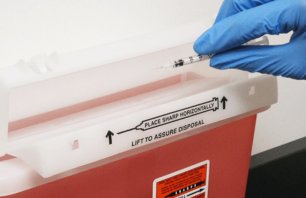The Hazards of Health Care
The health care industry has one of the highest rates of non-fatal work-related injuries of any sector, significantly more than the next highest category—manufacturing. Even construction, which one might think would have a high injury rate, is lower than health care. Here are several examples of hazards.
1. Overexertion and Slips, Trips and Falls
Health care facilities present a variety of hazards that have the potential to put staff safety at risk. For example, employees can injure their back, hips and knees during improper lifting of equipment, heavy items and of course patients during care delivery. Slips, trips and falls are also common workplace injuries experienced by health care professionals due to slick workplace conditions.
2. Medical Waste Handling
Another key area of risk is the handling and disposal of regulated medical waste. Employees can be exposed to biohazardous waste, and drugs and chemicals that are hazardous. This can lead to serious health issues if proper precautions such as personal protective equipment (PPE) are not present. Sharps-related injuries are also a serious concern as exposure to bloodborne pathogens, such as viruses or bacteria, can have far-reaching consequences if a staff member is infected.
3. Workplace Violence
The threat of workplace violence is another concern that cannot be overlooked. There is potential for patients, family members or employees to become verbally or physically aggressive due to a variety of reasons and such situations can be dangerous situations if specific protocols are not in place.
Ways to Mitigate the Risks of Heath Care Hazards
How can health care facilities create a safer environment and limit workplace injuries? The key is to put clear mitigation strategies in place that substantially reduce or eliminate risk. The following are four strategies to consider.
Conduct a Workplace Analysis
This involves a walkthrough of your facility with an eye toward potentially hazardous areas or risky behaviors. For instance, perhaps there are slick spots that could lead to slips or falls, or maybe staff are trying to lift patients on their own, using incorrect protocols. It could be that sharps disposal containers are located too far away from patient care areas or that hazardous chemicals aren’t appropriately labeled and stored. By periodically surveying the facility and identifying possible issues, you can more clearly see what needs to be addressed at your organization to preserve staff safety.
Develop Comprehensive Safety Plans
These detailed documents cover how an organization is going to ensure the safety of the environment and reduce the risk of injury. An especially important safety plan related to bloodborne pathogens exposure is the Bloodborne Pathogens Exposure Control Plan. The Occupational Safety and Health Administration (OSHA) requires health care organizations with the potential for exposure to create this type of plan, describing how the facility will use employee training, personal protective equipment, engineering controls, medical surveillance and more to keep staff safe.
Offer Robust Training
It is important to train staff on the different risks present in a health care facility and how they can prevent injuries. Topics to cover within new staff orientation, as well as regular refresher training could include how to correctly lift heavy items, how to prevent needlesticks, how to handle and dispose of hazardous materials and so on. Both online training and in-person experiences are valuable and offer different avenues for staff to receive the training they need.
Employ Engineering Controls
OSHA refers to engineering controls as a way to “implement physical change to the workplace, which eliminates/reduces the hazard on the job/task.” This can be accomplished through specially designed equipment that curbs the likelihood of injury. Some examples include hazardous drug waste containers that prevent access after disposal, sharps container design that limits potential needlestick injuries and equipment to mitigate improper use.
A Multifaceted Approach is Key
Worker safety is essential not just because it’s the right thing to do but to also maintain compliance with OSHA. Organizations that focus on identifying potential hazards and implement protocols to eliminate them can support a safer and more healthful environment. Learn how Stericycle can help your organization ensure compliance and reduce the risk of workplace injury.



